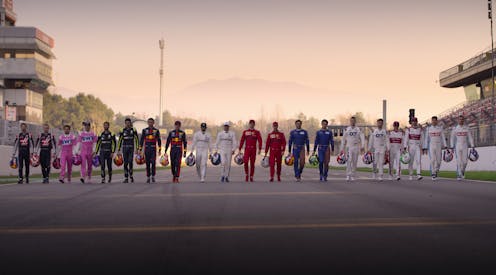How a Netflix show has become a key driver behind F1’s rising popularity
- Written by Raymond Boyle, Professor of Communications, University of Glasgow

Before the engines start revving for the start of the 2024 Formula One season, many fans will have already lapped up the newest episodes of Drive to Survive[1] on Netflix.
The latest series of the sports documentary[2] tells the story of last year’s competition, with cameras closely following the teams and drivers across the 22 races of 2023. A soap opera of sport, it is a story of success, failure and redemption, populated by heroes and villains.
Watched by millions since it launched in 2019, Drive to Survive is widely considered [3] to be a piece of high quality television, produced by skilled documentary makers. But it is more than just good telly. As a marketing tool for Formula One, it has been priceless.
The show is credited with creating a surge in the sport’s audience and crucially, driven down the average age of Formula One TV viewers from 44 to 32. This is a shift much valued by many commercial brands and broadcasters, who worry that live sport on television is not attracting a Gen Z audience.[4][5][6][7]
And it has not gone unnoticed by other sports, which are also keen (sometimes desperate) to expand their audiences and fan base, and have jumped on Netflix’s behind-the-scenes bandwagon. Golf (Full Swing), tennis (Break Point) and rugby union (Full Contact) are all now battling for viewers on the streaming service.
However, the success of Drive to Survive may be hard to replicate. It has glamorous locations, multiple narratives and a big cast of characters which is difficult to reproduce with individual sports.
And the show received huge backing from the company which took over Formula One[8] in 2017, Liberty Media.
As we set out in our forthcoming book, Streaming the F1 Rivalry: Sport in the Platform Age[9], the American company’s goal since then has been clear. It wants to attract new fans to the sport, grow revenues and extend the racing calendar across the globe, but specifically in the biggest media sports market in the world – the US.
And in Drive to Survive, they were quick to see a golden opportunity to reach audiences beyond the traditional motor-sports fan. In fact, it was a Liberty Media executive who reached out to Netflix with the idea of promoting the sport, with the crucial element of giving camera crews access to the inner sanctum of the Formuala One paddock, the area where teams set up before a race.
For in many ways Formula One is a sport ill-suited to television. Visually, the skills of the drivers are partly hidden inside the car, their facial expressions impossible to read behind a helmet.
In other sports, the televised event is all about getting up close and personal so we can admire technique and finesse, whether it’s a Novak Djokovic forehand, or the dancing feet of Mo Salah. We also see the athletes’ raw reactions to both success and failure.
In Formula One, television needs to work much harder. It relies heavily on detailed commentary, a multitude of cameras and access to communication between drivers and their engineers. There are onscreen graphics with data that attempt to make sense of a complicated sport which combines cutting edge technology with pushing the limits of human endurance.
But even with those elements, to some viewers, watching a race might lack excitement. Drive to Survive has stepped in to make the sport more attractive by revealing the human stories, and giving audiences the chance to emotionally invest in the drivers, teams and the personal rivalries.
It used to be newspapers which provided that narrative[10]. Today, while the print media still has a role, much greater importance is given to what emerges online – whether that’s through social media, on podcasts and YouTube, or on Netflix. It is those channels which provide the chatter which in turn drives interest in Formula One.
Liberty Media understand this because they are not in the sports business in the way that organisations like Fenway Sports Group[11] (current owners of Liverpool FC) are. Liberty Media is in the entertainment industry, and it wants to entertain.
But nothing in sport can be guaranteed. It thrives on the unexpected, the sense that on the day, anything can happen. It is unscripted drama, which is what differentiates elite sport[12] from other more choreographed cultural activities such as live music concerts and theatre.
But these values and attributes do not always sit well with broadcasters who are selling entertainment to audiences. If things become too dull and too predictable, fans and viewers may lose interest. Formula One regulations are often tweaked and changed deliberately to keep things interesting.
Last year the season had exciting races[13], dull races[14] and everything in between.
And while Drive to Survive may provide a pleasing appetiser, Liberty Media will be watching intently as the action unfolds on and off the track, hoping that it will prove exciting and entertaining enough to retain its old fans – and attract lucrative new ones.
References
- ^ Drive to Survive (www.formula1.com)
- ^ sports documentary (journals.sagepub.com)
- ^ widely considered (theathletic.com)
- ^ sport’s audience (www.forbes.com)
- ^ 44 to 32 (www.autosport.com)
- ^ commercial brands (www.formula1.com)
- ^ Gen Z audience. (digitalcontentnext.org)
- ^ took over Formula One (www.libertymedia.com)
- ^ Streaming the F1 Rivalry: Sport in the Platform Age (www.peterlang.com)
- ^ provided that narrative (www.tandfonline.com)
- ^ Fenway Sports Group (fenwaysportsgroup.com)
- ^ differentiates elite sport (www.tandfonline.com)
- ^ exciting races (www.autosport.com)
- ^ dull races (www.sportskeeda.com)







